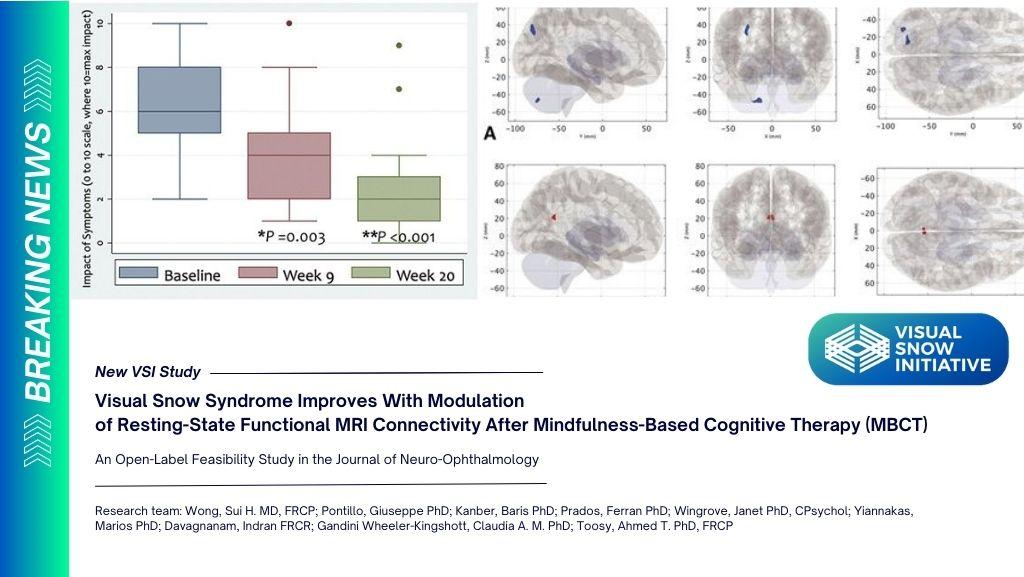Study Title
Publisher
Researchers
Wong, Sui H. MD, FRCP; Pontillo, Giuseppe PhD; Kanber, Baris PhD; Prados, Ferran PhD; Wingrove, Janet PhD, CPsychol; Yiannakas, Marios PhD; Davagnanam, Indran FRCR; Gandini Wheeler-Kingshott, Claudia A. M. PhD; Toosy, Ahmed T. PhD, FRCP
Abstract
Background
Visual snow syndrome (VSS) is associated with functional connectivity (FC) dysregulation of visual networks (VNs). We hypothesized that mindfulness-based cognitive therapy, customized for visual symptoms (MBCT-vision), can treat VSS and modulate dysfunctional VNs.
Methods
An open-label feasibility study for an 8-week MBCT-vision treatment program was conducted. Primary (symptom severity; impact on daily life) and secondary (WHO-5; CORE-10) outcomes at Week 9 and Week 20 were compared with baseline. Secondary MRI outcomes in a subcohort compared resting-state functional and diffusion MRI between baseline and Week 20.
Results
Twenty-one participants (14 male participants, median 30 years, range 22–56 years) recruited from January 2020 to October 2021. Two (9.5%) dropped out. Self-rated symptom severity (0–10) improved: baseline (median [interquartile range (IQR)] 7 [6–8]) vs Week 9 (5.5 [3–7], P = 0.015) and Week 20 (4 [3–6], P < 0.001), respectively. Self-rated impact of symptoms on daily life (0–10) improved: baseline (6 [5–8]) vs Week 9 (4 [2–5], P = 0.003) and Week 20 (2 [1–3], P < 0.001), respectively. WHO-5 Wellbeing (0–100) improved: baseline (median [IQR] 52 [36–56]) vs Week 9 (median 64 [47–80], P = 0.001) and Week 20 (68 [48–76], P < 0.001), respectively. CORE-10 Distress (0–40) improved: baseline (15 [12–20]) vs Week 9 (12.5 [11–16.5], P = 0.003) and Week 20 (11 [10–14], P = 0.003), respectively. Within-subject fMRI analysis found reductions between baseline and Week 20, within VN-related FC in the i) left lateral occipital cortex (size = 82 mL, familywise error [FWE]-corrected P value = 0.006) and ii) left cerebellar lobules VIIb/VIII (size = 65 mL, FWE-corrected P value = 0.02), and increases within VN-related FC in the precuneus/posterior cingulate cortex (size = 69 mL, cluster-level FWE-corrected P value = 0.02).
Conclusions
MBCT-vision is a potential treatment for VSS, with benefits that translate to quality of life, self-efficacy, and wellbeing. This feasibility study supports the rationale for a randomized controlled trial that includes MBCT-vision as a treatment arm (ClinicalTrials.gov identifier: NCT06018103, www.MBCT-vision.co.uk). Our study showed that mindfulness intervention can change organization of functional networks on fMRI, an objective observation raising the possibility of mindfulness therapy in the treatment of other neurological conditions.


